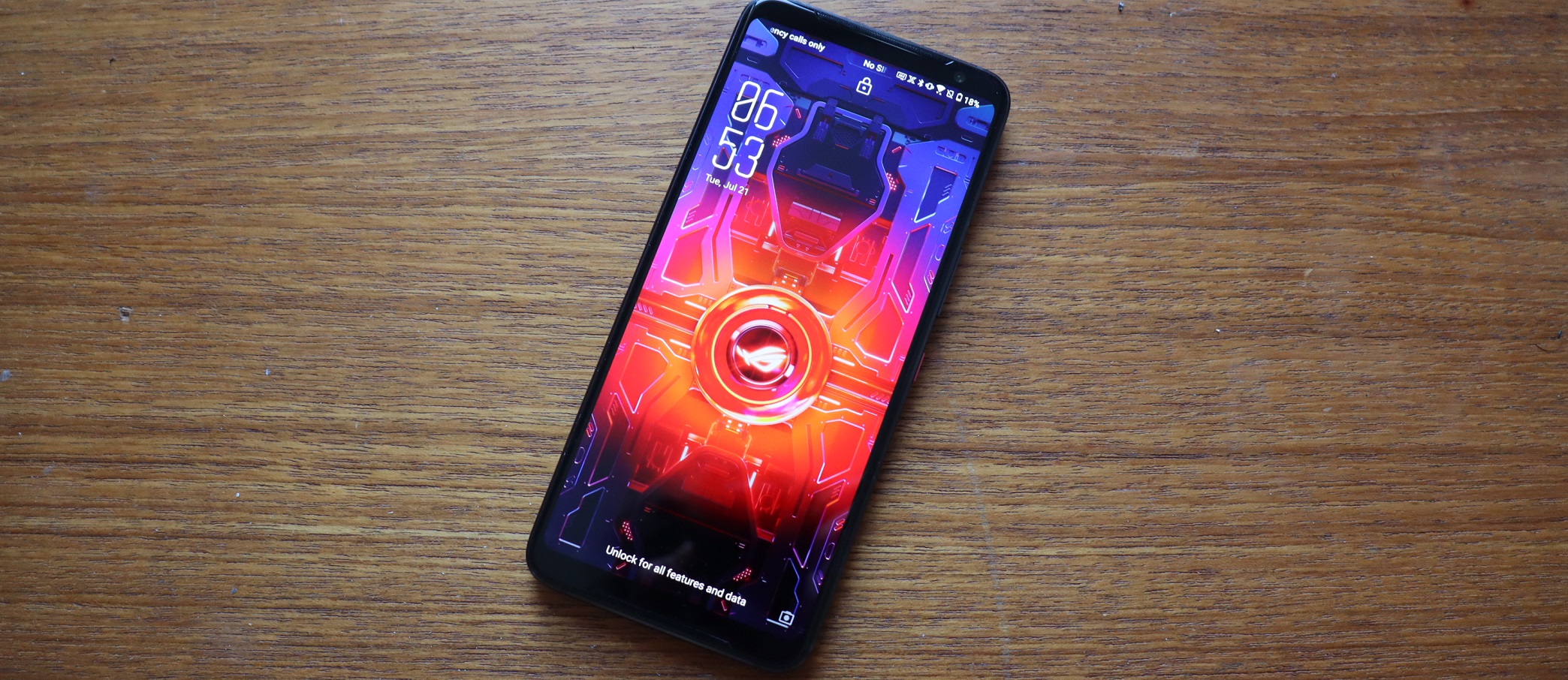TechRadar Verdict
The Asus ROG Phone 3 is a fantastic phone, with top-tier specs and perks that even non-gamers will love, like a 6,000mAh battery and smooth 144Hz display. Its unique features, like AirTriggers and clip-on accessories, could improve anyone’s gaming, though they’ll have to fiddle with the software to activate them. On the other hand, its gamer-centric software and looks won’t appeal to all, and its cameras leave something to be desired. It’s the most mainstream gamer phone to come out in awhile, but typical consumers may value photography over playtime. For the gamers out there, though, there’s no better machine.
Pros
- +
Absolute best specs in phones
- +
6,000mAh battery and 144Hz screen appreciable by non-gamers, too
- +
AirTriggers are neat
Cons
- -
So-so cameras
- -
AirTriggers and other gaming features only work with select games
- -
No wireless charging
Why you can trust TechRadar
Two-minute review
The Asus ROG 3 is one of the most advanced gaming phones ever released, if not the most advanced. Its blend of gaming-focused hardware and software features justify its existence in a crowded field, and gamers willing to spend more can actually get an edge with the ROG 3.
The same could be said about its predecessor, the Asus ROG II – you’re certainly going to have an advantage when it comes to performance thanks to top-tier specs and tighter control via the ROG-branded game controllers. The Asus ROG 3 is the Asus ROG II, but better.
The differences between the two phones are worth pointing out. This is the first smartphone with the Snapdragon 865 Plus chipset, and it outperformed nearly every other phone we’ve tested on Geekbench. And the ROG 3’s looks are the most mainstream yet: rather than the original ROG Phone’s Decepticon-like lines and angles, the new handset has a sleek flat back with only a clear plastic window giving a peek at the internals hinting at the phone series’ gamer chic origins.
Asus execs claim that supercars inspired this design shift, but it’s hard not to see the transition as a concession to a more mainstream smartphone look, to draw in consumers who don’t go for aggressive lines and RGB adornments. Showing it off won’t garner you much cred in gamer circles, but normies will be able to take it out in public without raising too many eyebrows.
Instead, all the progress is on the inside: in addition to the aforementioned Snapdragon 865 Plus, the ROG 3 ups the RAM to 16GB (and opts for DDR5) while the display has been improved to 144Hz refresh rate and 270Hz touch sampling. Asus claims this results in a halving of the touch latency to 25ms compared to the ROG II – and while such distinctions won’t be perceivable to most users, Asus knows that such marginal improvements will appeal to its performance-obsessed core base.
While those power users might be sore over the visual redesign, in most other respects the ROG 3 is a love letter to them. Asus’ signature Armoury Crate software has even more settings for owners to tinker with, from CPU and GPU refresh rates to internal temperature control and network preferences. The AirTriggers, which operate like touch shoulder buttons when the phone is held in landscape orientation, have been refined to track fingers making gestures that previous ROG phones couldn’t track for more finite control.
Asus wanted to do all of this while retaining the ROG II’s general shape and weight, to keep it compatible with earlier peripherals, but fitting in the external 5G modem meant something had to go, and the ROG 3 ditches the beloved 3.5mm jack; however there’s one of those on the AeroActive Cooler 3 clip-on fan (which is included in the box), so it’s not the end of the world.
The AeroActive Cooler 3 fan has been upgraded, as have the newest versions of the ROG 3’s signature peripherals. The refined Kunai 3 Gamepads, for instance, lose their angular look, bringing them even closer in appearance to Switch Joy-Cons than the ROG II’s controllers.
Outside of gaming, the phone ticks most boxes, with a triple rear camera array comprising 64MP main, ultra-wide, and macro shooters – which are fine, although the lack of a serious zoom capability is noticeable. And some of the phone’s gaming-centric features are also a boon for the casual user, with the 144Hz display making web browsing and interface navigating a smooth experience, while the 6,000mAh battery is handy to keep your phone lasting longer than a day.
Overall, the Asus ROG 3 is a strong phone that offers fantastic performance, a smooth display, a colossal battery, and a more mainstream-friendly design – and on paper, all the gaming features make the phone seem like a serious contender against the current crop of flagship phones, gaming-focused or otherwise. But the software-focused gaming perks require some dedicated finagling, and won’t benefit casual users, while its camera suite isn’t as strong as other phones at its price point. The Asus ROG 3 is a great gaming phone, but it’s not quite for everyone yet.
Asus ROG Phone 3 price and release date
- Launched: July 22, 2020; Release date: September 2020
- Regional availability: US
- Price: $999 (around £752 / AU$1,500)
Weight: 240g
Dimensions: 171 x 78 x 9.85mm
Display size: 6.59-inch
Resolution: FHD+ (2380x1080)
Refresh rate: 144Hz
Pixel density: 391ppi
Chipset: Snapdragon 865 Plus
RAM: 12GB / 16GB
Storage: 512Gb
Rear cameras: 64MP + 13MP + 5MP
Front camera: 24MP
Battery: 6,000mAh
The Asus ROG 3 was announced on July 22, 2020, although pricing seriously lagged behind its proper September release date in many regions. It's available in the US at least, starting at $999 (around £752 / AU$1,500), though it's unclear when it'll be sold in the UK, Australia, and elsewhere.
The ROG 3 isn't sold by US carriers, which hurts its availability. You'll have to buy it directly from Amazon, B&H, or Mobile Advance.
Given that the Asus ROG II cost $899 / £829.99 (roughly AU$1,500) for its only configuration, the ROG 3’s pricing (at least for the 12GB RAM model, with the 16GB RAM version likely higher-priced) isn't too surprising given the added 5G connectivity. Many phones having increased their pricing by $100 / £100 to cover the cost of adding 5G-supporting chipsets and connectivity.
We do know one thing: the Asus ROG 3 will only come in a black finish.
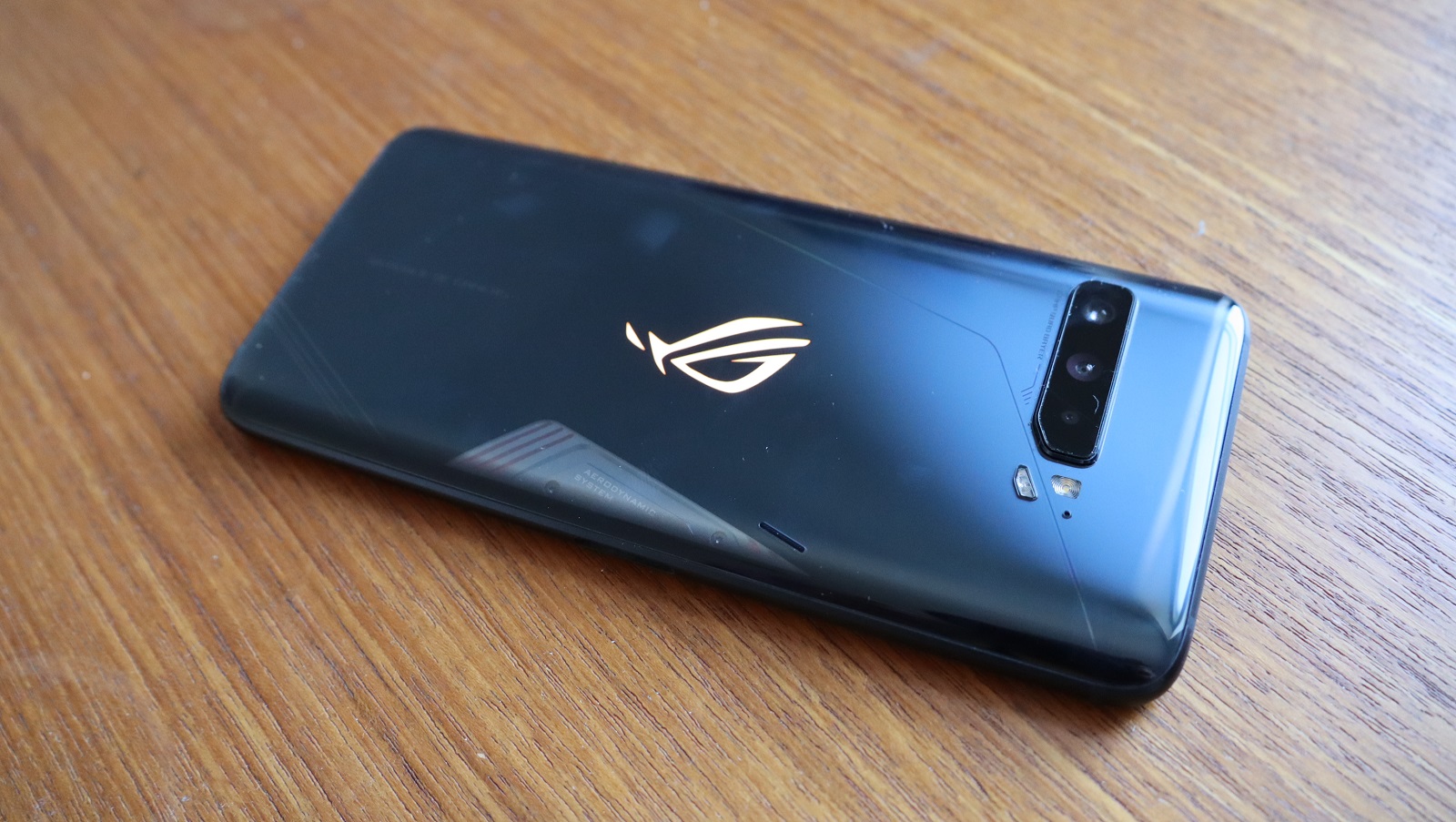
Design
- Same size & weight as the ROG II to ensure compatibility with accessories
- Less 'gamer chic' angles & lines for a cleaner, mainstream look
- Upgraded AirTrigger touch shoulder buttons
The Asus ROG 3 edges closer towards the look of mainstream phones with a mostly seamless back marked with more subtle accents than its predecessor, bringing the phone closer to the sleek (though not necessarily black) rectangle look the industry has settled on. The sharp-angled cutouts of its predecessors have been reduced to a spare few lines running across the ROG 3’s back.
Of course, mainstream phones don’t have a window cutout on the back, revealing the heat sink that runs nearly half the length of the phone, which is six times larger than the window on the ROG 2 – this is the ‘supercar’ look, as Asus executives explained to media, and while there’s an RGB ROG logo in the center of the phone’s rear, aside from the small rear camera strip it’s as smooth as any other flagship.
If you want that sweet angular ‘gamer chic’ look, the official ROG 3 Lighting Armor cases provide it, with cutouts for the AirTriggers and ports, along with a neat RGB lighting effect that spans nearly the whole rear cover.
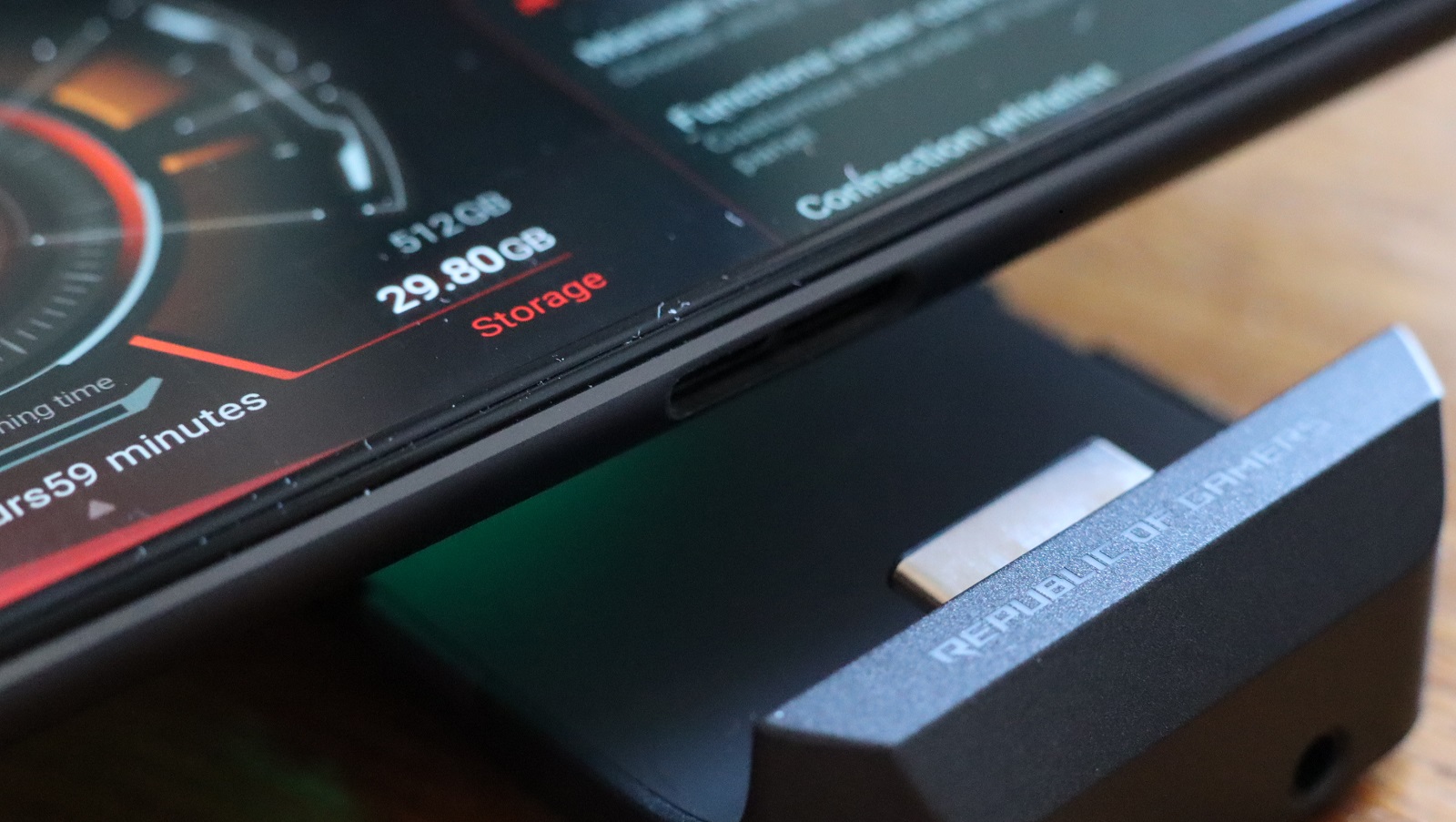
That’s ports, plural. Along with a standard USB-C connection on the bottom, the ROG 3 has a large double port on the left side of the phone that faces down when you rotate the phone sideways for gaming, letting you recharge while you play; this is also where you’ll plug in any of the many ROG 3 accessories (described below). You’ll only need the left half of the port to plug in your USB-C charger – the right side is just for said accessories to transfer data, per this Asus FAQ.
A word of advice though: if you plan to make use of the big port while you’re on the go, you should take some tweezers with you, as the protective plug is tough to pry out with fingernails alone.
On the right side are the power button and volume button rocker, located halfway down to avoid getting in the way of the phone’s other signature feature: the AirTriggers. These have been improved over the AirTriggers on the Asus ROG II, with motion sensors that recognize more gestures, adding a back-and-forth slide to the existing taps and swipes. Better still, they’re sensitive enough to enable each AirTrigger to be split into two distinct buttons, enabling an L1/L2/R1/R2 experience if you’re dextrous enough.
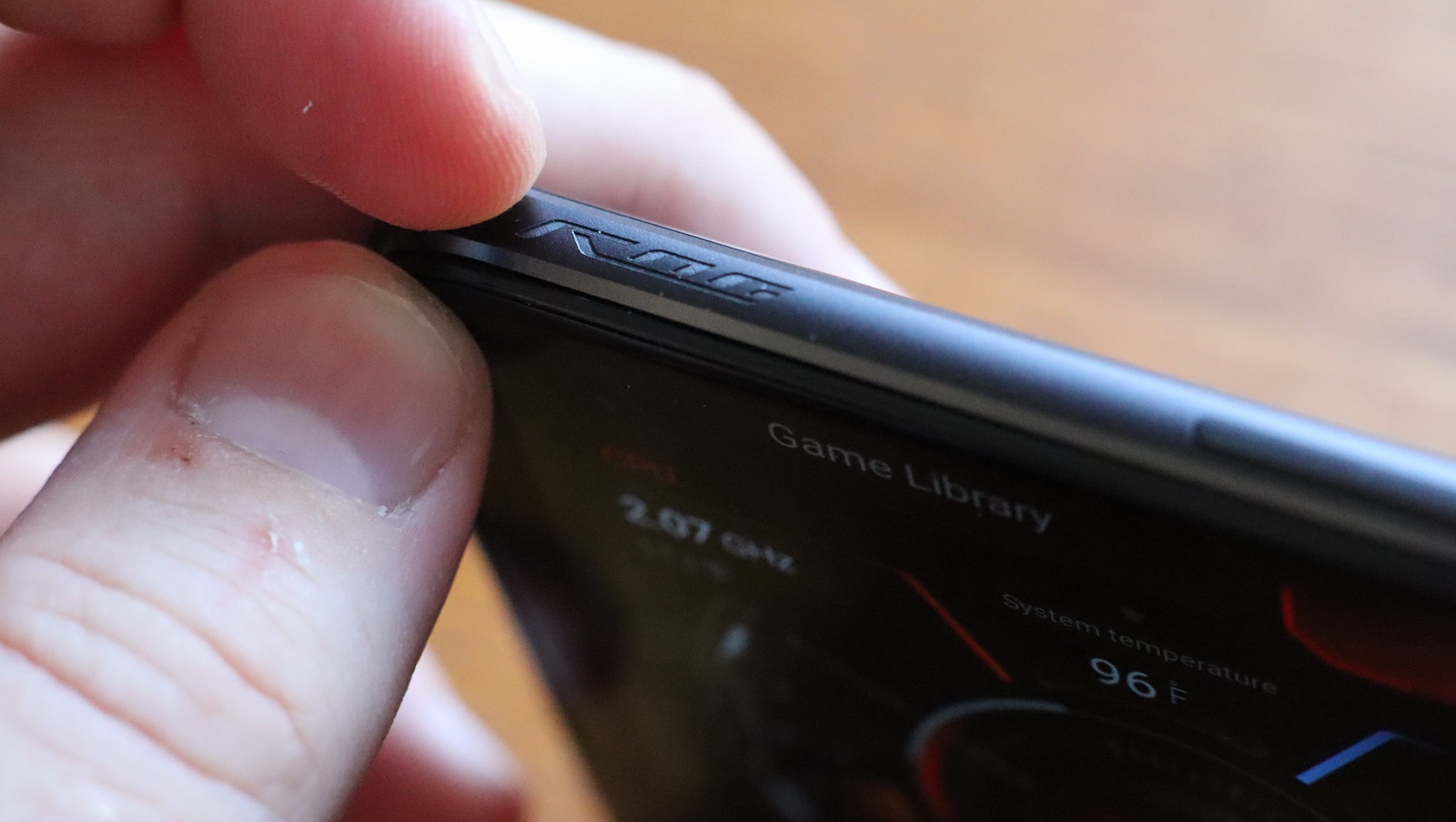
Like the ROG II and original ROG Phone, the ROG 3 is designed such that no parts get in the way of gaming. Asus has even expanded the number of microphones – there are four now, including one on the back near the flash – to ensure that, no matter how many accessories you clip onto the phone, you can still trash-talk your opponents.
The speaker array also includes the dual forward-facing speakers, tucked in the bezels at the top and bottom. In our ‘testing’ (read: heavy PUBG and Call of Duty: Mobile sessions), we didn’t inadvertently cover them with our fingers while in-game – and that’s a good thing, as Asus has partnered with Swedish music company Dirac to tool-up the sound on the ROG 3, resulting in a rounder, fuller-bodied sound than you’ll get from most other phones on the market.
Yes, we even like the audio experience better than that on our longtime favorite phone speakers-wise, the Google Pixel 4, mostly because the ROG 3’s speakers project sound much more evenly: we twirled the phone around to listen from many different angles, and the sound profile barely changed. It’s not louder, but you will hear a nearly-full range of sound no matter where the ROG 3 sits in relation to you.
If you’re a fan of wired headphones you’ll be disappointed to learn that, as mentioned earlier, the 3.5mm jack is no more – if you want to use your regular headphones, but want to avoid dongles, the included-in-the-box fan has a traditional headphone jack.
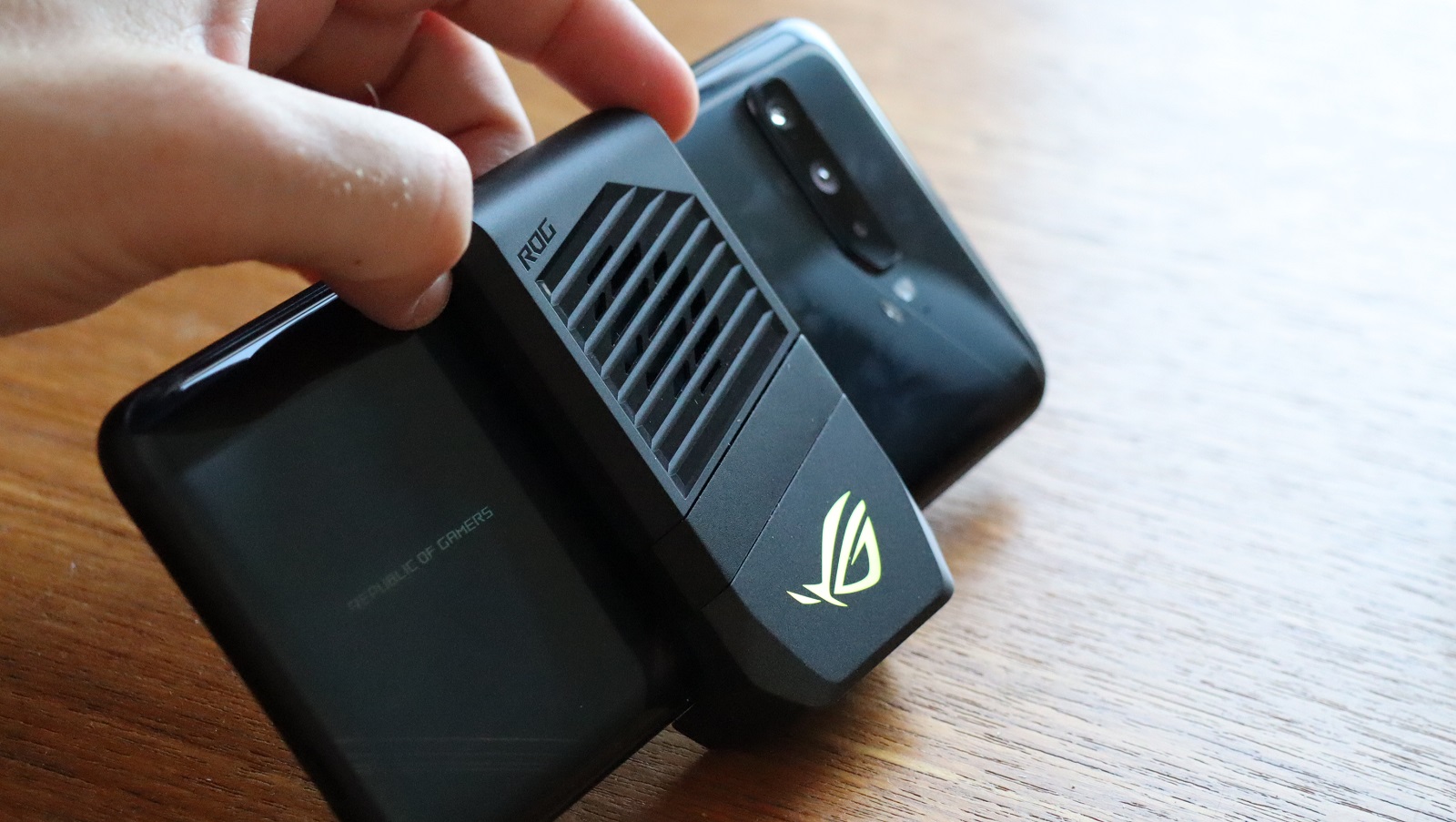
ROG 3 accessories
- Mostly gaming-focused, from controllers to docks
- AeroActive Cooler 3 clip-on fan, included with phone
- Kunai 3 controllers look less angular
The Asus ROG 3 isn’t just a phone – like the previous ROG models, it’s the core device of a gaming platform, with several optional accessories that are mostly geared toward augmenting mobile gaming.
The most widely-useful of these is the clip-on fan, the AeroActive Cooler 3, which, as we’d hope with a gaming phone, is included in the box. This plugs into the side-mounted dual port to help keep the ROG 3 cooler during intense gaming sessions; we never found the phone got so hot that it required the fan, but it’s nice to have – and best of all, it has the aforementioned a pass-through 3.5mm jack for plugging in your headphones. It’s also got a little kickstand that, while a bit flimsy, is a nice inclusion.
The other accessories aid gaming more directly: the TwinView Dock 3 adds a second screen, which is much like the LG V60 Dual Screen in the sense that it’s identical to the main phone’s display, with the same resolution and 144Hz refresh rate. Sure, it can help you multitask, but it’s really about playing with multiple screens, so you can watch one and press buttons on the other.
The ROG Kunai 3 Gamepad is the most straightforward accessory, with a smoother look than the Kunai controllers launched with previous ROG phones. This works much like the Nintendo Switch Joy-Cons: it consists of two controller halves which can be used as separate right and left controllers locked to the sides of the ROG 3 when it’s fitted into a special ‘bumper’ case, or slid onto a frame to handle like a proper gamepad.
There’s also the ROG clip, which secures the phone to a PS4, Xbox One, or Google Stadia controller (sorry, it won’t fit a PS5 or Xbox Series X controller, if you were wondering). There’s a pair of docks, too, with a slew of ports to hook the ROG 3 up to keyboards and mice: the more portable Professional Dock and the Mobile Desktop Dock, which adds a 3.5mm audio jack and more input/output ports.
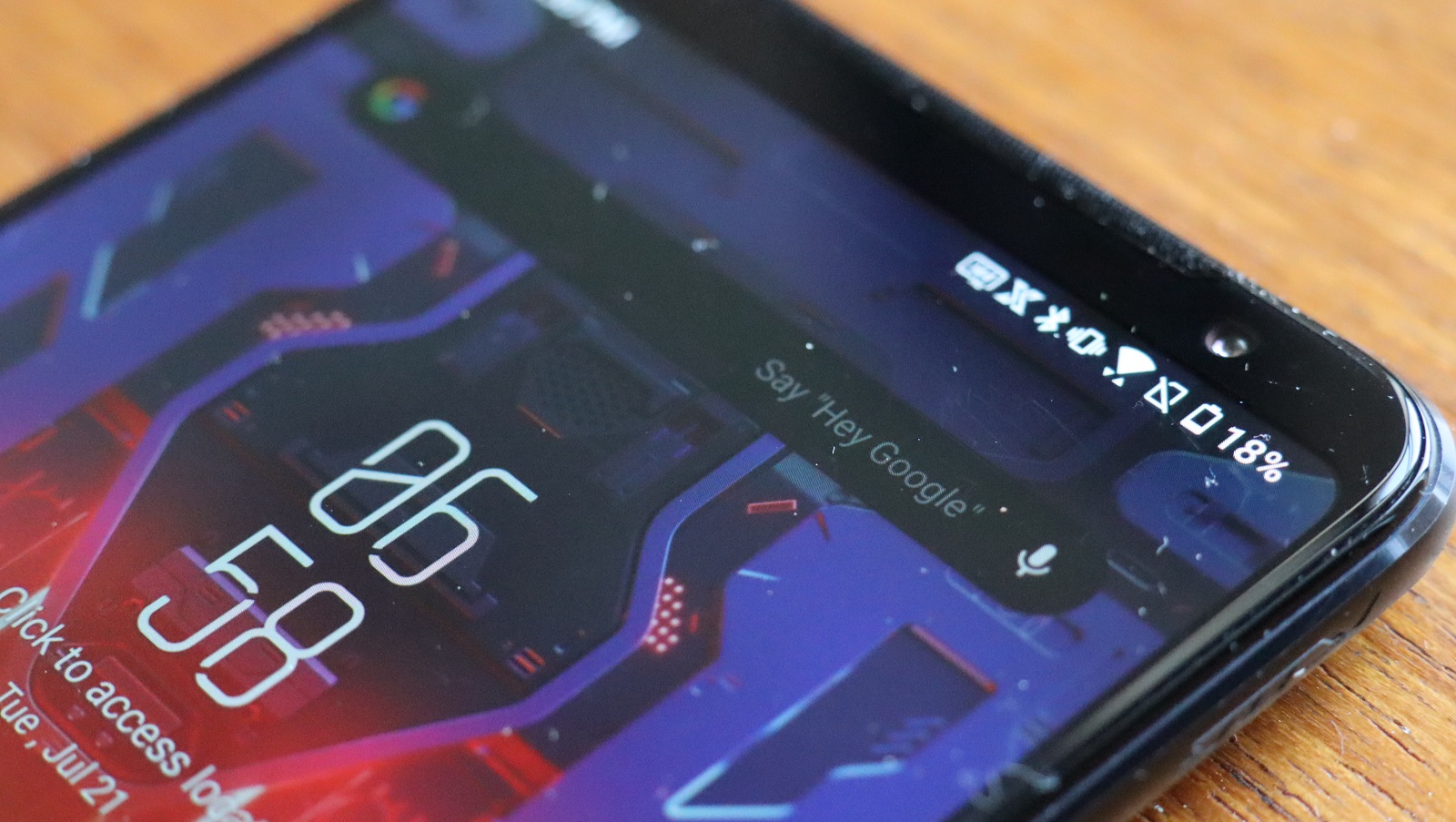
Display
- Same 6.59-inch Full HD Plus OLED display as ROG II
- Refresh rate has been upgraded from 120Hz to 144Hz
- HDR10+ support, but has trouble rendering the darkest blacks
The Asus ROG 3 packs virtually the same 19.5:9 ratio, 6.59-inch AMOLED display as its predecessor, with one big change: the upgrade from a 120Hz maximum refresh rate to 144Hz.
The display’s Full HD+ resolution (2340 x 1080) isn’t the sharpest on a phone – the Samsung Galaxy S20 line’s 3200 x 1440 QHD Plus screens take that honor. But you won’t notice when watching most media or playing most games, especially when these feature colorful and well-lit scenes, thanks to the inclusion of HDR10+ support.
It’s the dark corners, or dimly-lit scenes, that trouble the ROG 3’s display, which has a tendency to lose clarity when showing deep blacks. Take a show like The Witcher, for instance, in which the extreme darkness in the occasional torch-lit scenes is rendered as great patches with pixelated edges.
The display’s strength lies in its fast refresh rate, although only a handful of games currently support the absolute extreme of 144Hz. When testing one of these, Dead Cells, we found the game to be smooth, but not perceptibly smoother than when playing on a Samsung Galaxy S20 Plus, which maxes out at 120Hz.
The ROG 3 has no notch or punch-hole – instead, its selfie camera is set in a black bar, a rare design feature in flagship phones these days, and while not desirable in mainstream handsets, this makes it simpler to enjoy media. The display also houses an in-screen fingerprint sensor, which is fast-acting and accurate.
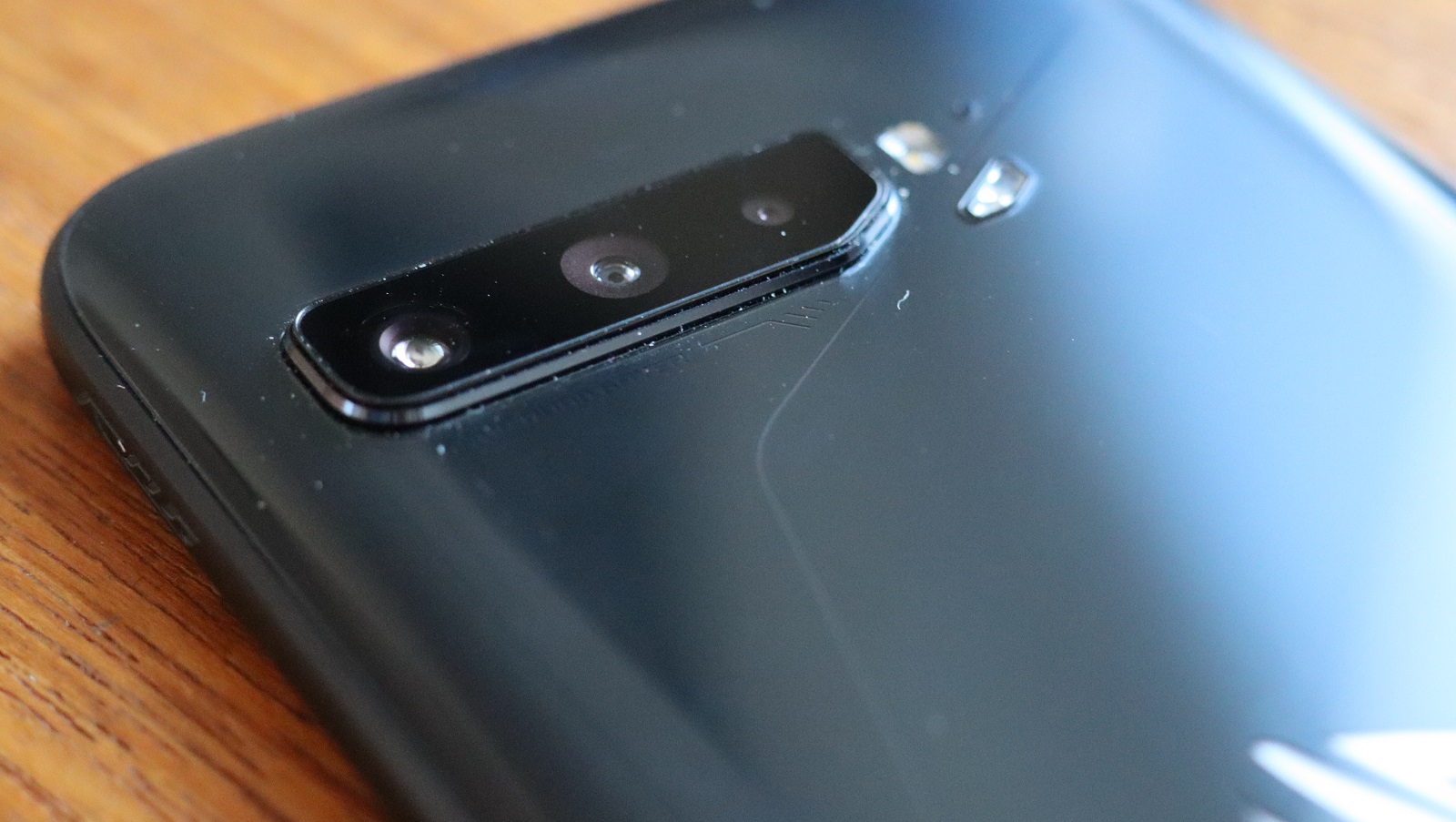
Cameras
- Triple rear cameras: 64MP main, 13MP ultra-wide, and 5MP macro
- Respectably sharp photos, though light nuance isn't as good as top camera phones
- 24MP front-facing camera is fine
The Asus ROG 3 has expanded its photographic suite to three rear cameras, one more than on the ROG 2. The new addition, a macro camera, has been popping up on lower-end phones as a novelty option, and while it’s nice to see here, we’d have preferred a telephoto camera, although we can imagine the stacked lenses might have taken up too much space.
The 64MP main shooter takes good photos – it’s not quite at the level of the cameras on the iPhone 11 or the Google Pixel 4, but it’s close enough for a gaming phone.
You’d need to look at shots side-by-side to pick out where the ROG 3 is lacking. For instance, the ROG 3’s main camera doesn’t quite reach the sharpness of the Samsung Galaxy S20’s, either with close-up details (like leaf edges) or distant detail in street shots.
Additionally, area around light sources can appear washed out compared to identical scenes shot with the iPhone 11 Pro Max, and nor does the camera capture the nuance between differently-lit adjacent subjects as well as the Google Pixel 4 does, in the clouds of a sunset, for example.
It’s nice to see that the 13MP ultra-wide camera takes photos that look similar in quality to those from the main camera, which isn’t always the case: some phones’ ultra-wide lenses have noticeably poorer low-light capabilities.
Don’t expect the ROG 3 to take good low-light shots, however, as its Night Mode only somewhat brightens dark scenes, and far less so than leading iPhone and Google Pixel handsets.
The ROG 3 does, however, shoot video in up to 8K at 30fps through its main rear camera.
The 5MP macro camera works fine, taking reasonably well-detailed photos of close-up subjects. The 24MP front-facing camera also works just fine, adding respectable background blurring effects to portrait shots.
Camera samples








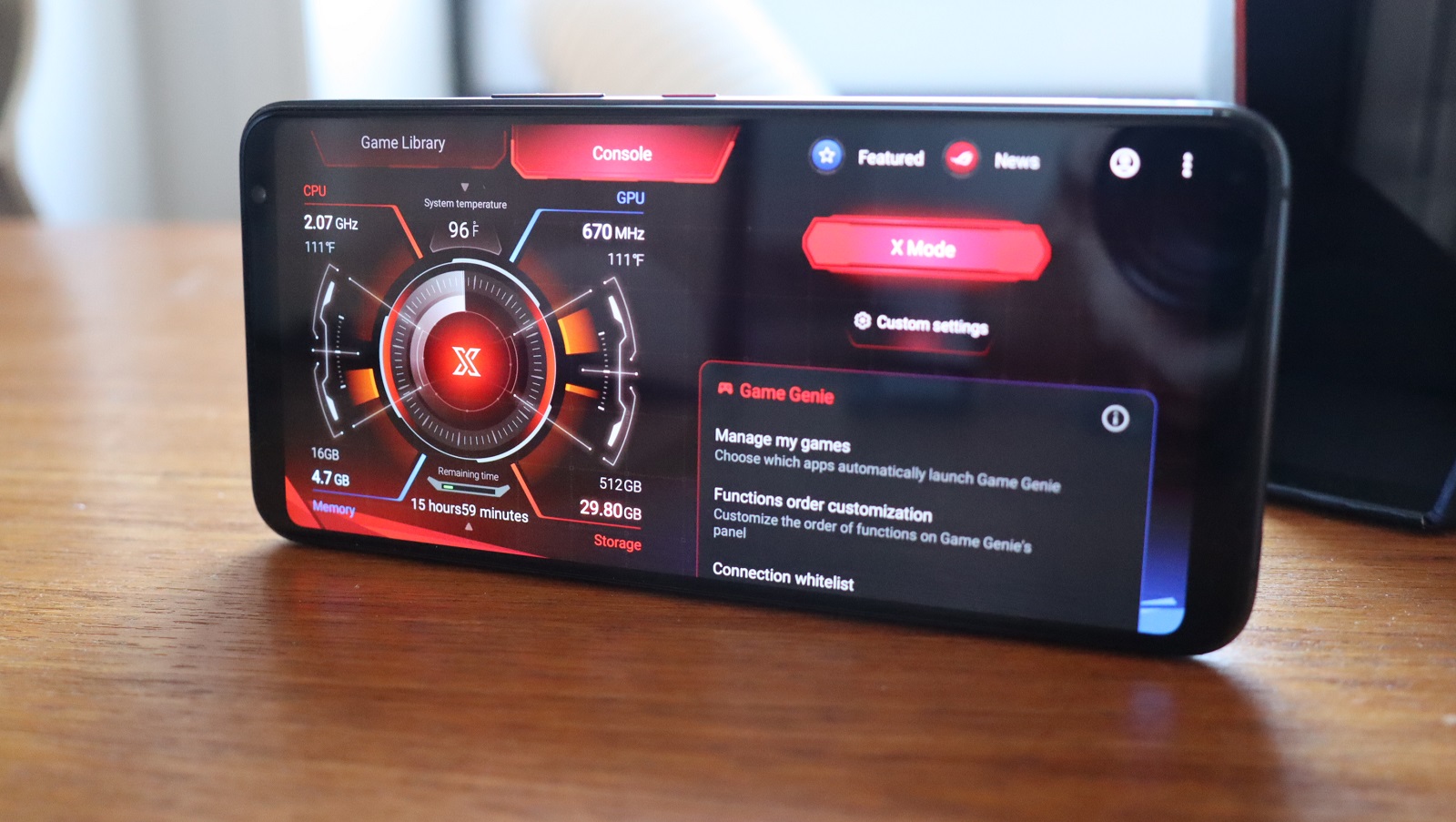
Performance
- Snapdragon 865 Plus chipset and up to 16GB LPDDR5 RAM make it a powerhouse
- Geekbench scores outpace all but a couple phones
- No slowdown, no lag, no stopping this gaming beast
The Asus ROG 3 is the most powerful gaming smartphone out there at the time of its release. Between a Snapdragon 865 Plus chipset – one of the first phones to feature that processor – and either 12GB or 16GB of LPDDR5 RAM, the phone has better specs in this department than nearly any other handset on the market.
The result is smooth on-screen action and no hint of slowdown or lag, no matter how intense the gaming session or long the media binge session.
The ROG 3 outpaced most other phones with its Geekbench 5 benchmarks, averaging a 3340 multi-core CPU score. But with the phone's performance-enhancing X Mode enabled, the results shot up to 3404 – outpacing everything but the OnePlus 8, which had comparable scores, and the current leader, the iPhone 11 Pro Max with a score of 3424.
The Asus ROG 3 features a mobile version of the Armoury Crate software found in its PC offerings, which allows for similarly granular control of gaming-related features. The options here are mostly for tinkering with gameplay enhancements for each game, though there are minute settings that let you tinker with general/overall performance and heat thresholds.
The Asus ROG 3 comes with Android 10 out of the box, and it will be getting Android 11 when it comes out later in 2020, though it’s unclear if the phone will be upgraded after. It will get two years of guaranteed security updates, though.
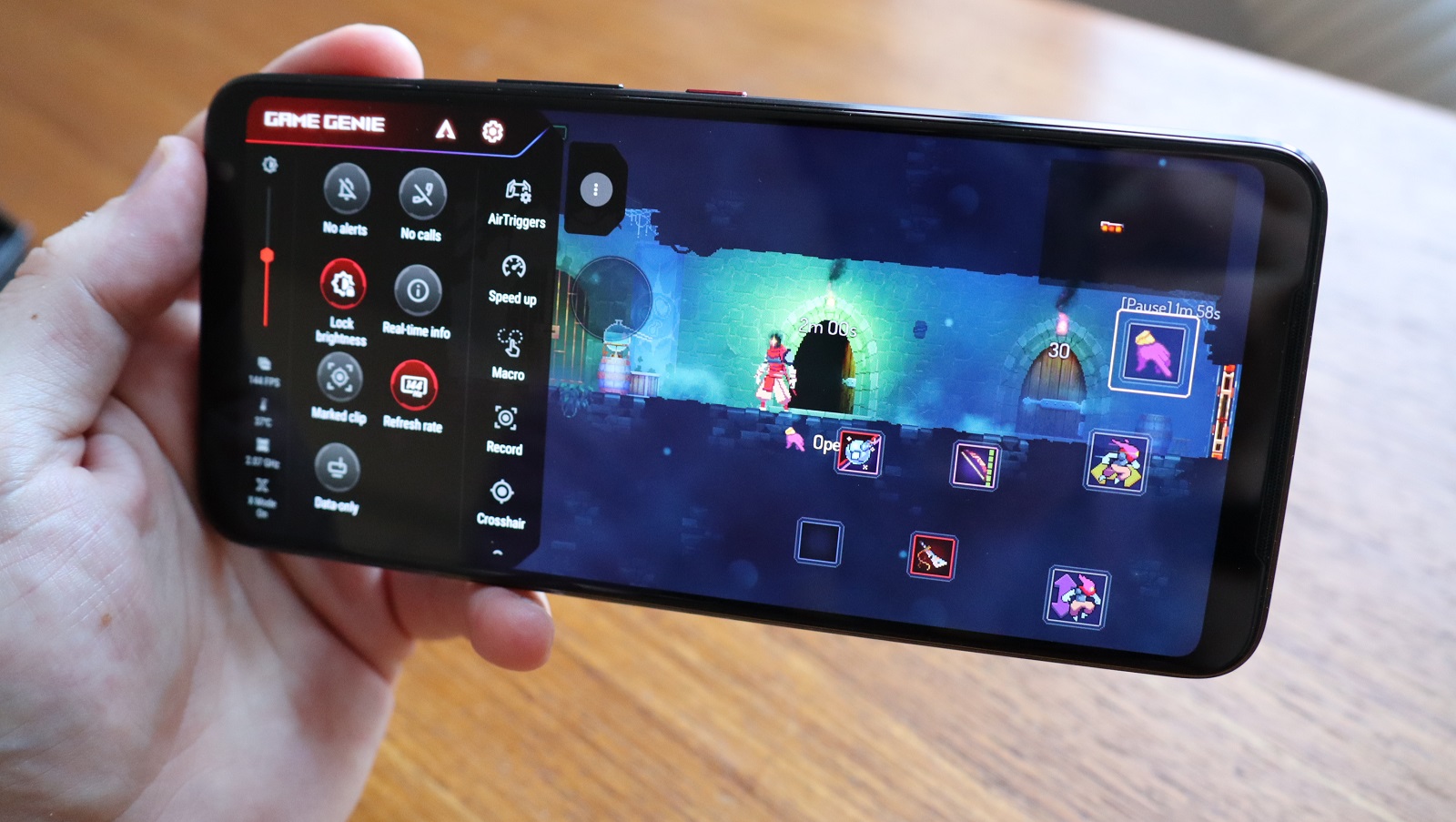
Gaming
- Gaming features are neat but either have limited compatibility or have imperceptible effects
- AirTriggers and 144Hz are only compatible with a handful of games
- Even without tweaking, high specs mean no slowdown while gaming
So what’s it like to game on the ROG 3? We didn’t get a chance to play with the new Kunai 3 gamepads, nor with any of the docks or other fancy accessories, so we’re really just reporting on the out-of-the-box gaming experience – and it’s undeniably good.
The pixelated dark patches that pop up when your binge-watching media don’t crop up when you’re gaming – possibly because most games have brighter visuals anyway, but it’s worth noting.
Even before you start messing with the Armoury Crate settings, playing mobile games casually is enjoyable, with no slowdown. The complex cooling system – consisting of a graphite film layer, 3D vapor chamber, and a huge vapor chamber – keeps the rear of the phone from getting too warm, even over the duration of a 15-minute PUBG battle royale match – a session of similar length would turn the Samsung Galaxy S20 Plus’ rear cover hot enough to be uncomfortable to rest your fingers on.
The AirTriggers can be helpful, but the process for setting them up is tucked away in the FAQ: in the middle of a game, you need to swipe in from the left to bring up Game Genie features menu, and tap AirTriggers to set the location corresponding to each shoulder button, along with which gesture (tap, swipe, slide, etc) you’d like to trigger.
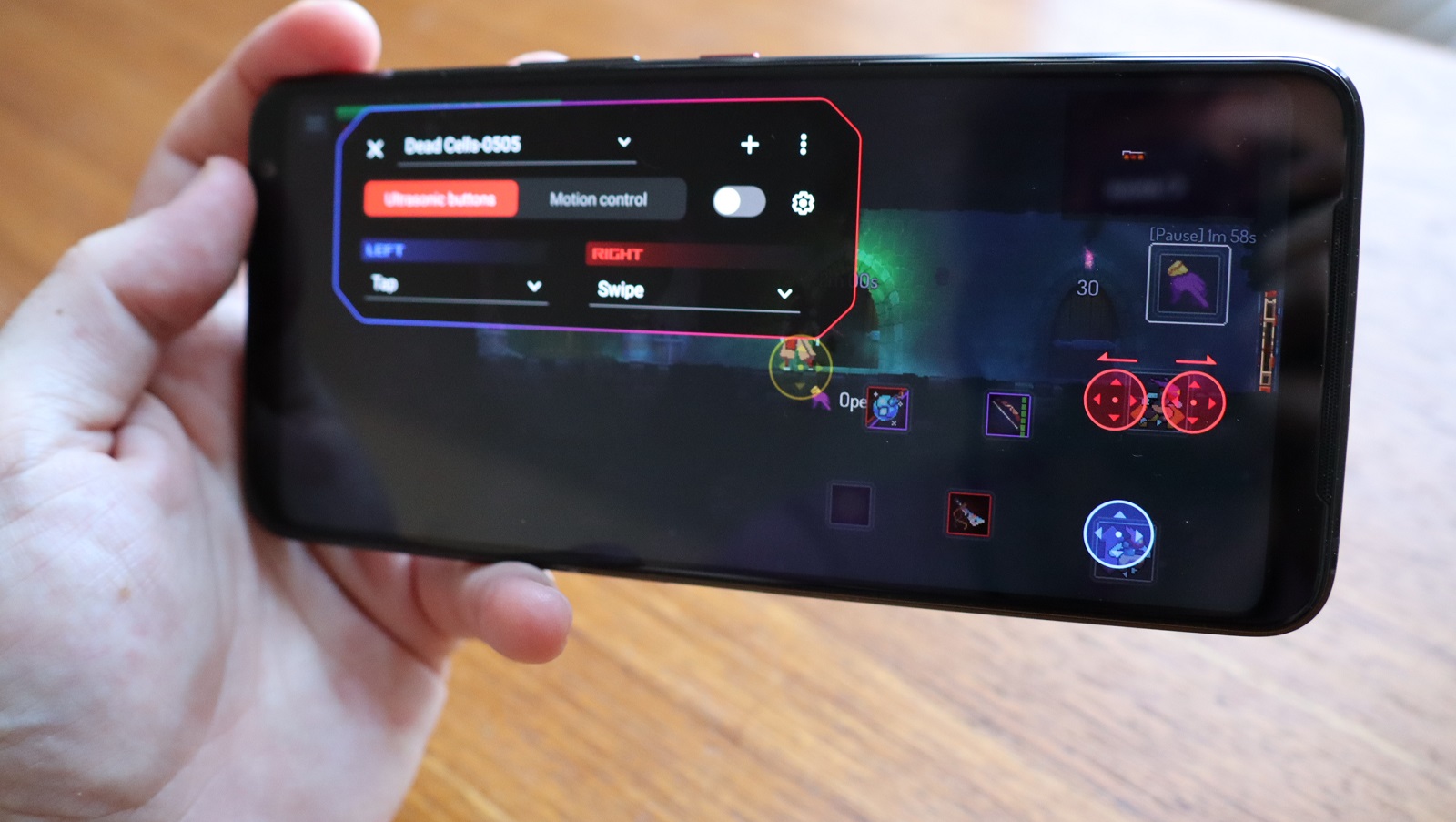
Unfortunately, few games are compatible at the moment, meaning that we only got to enjoy the feature while playing PUBG. It was nice to be able to map an AirTrigger to fire our guns, but we still daydreamed about how much some slide-to-dash AirTrigger functionality could help us while playing Dead Cells.
The Armoury Crate features themselves are customizable, but the results of tweaking settings weren’t necessarily noticeable: we fired up Call of Duty: Mobile and boosted the performance all the way up, but couldn’t tell a difference, even after a battle royale. Either the phone’s specs were indeed that good, or we just don’t know how to push this phone to its breaking point.
In other words, we had plenty of tinkering options at our fingertips, but often we just dived into games with default settings and they played just fine. No doubt there are players out there who could push the system to its limits, but I doubt there are many, if any, games available that could really test this phone.
But that’s just the performance areas we noticed, and there are other advantages Asus claims gamers get with the ROG 3 that are nigh-imperceptible. The display’s 270Hz touch sampling rate and 25ms touch latency should, in theory, allow you to out-tap any other phone – including the Samsung S20 line and the OnePlus 8 line, both of which have 240Hz touch sampling rates. However, it’s hard to find comparable touch latency figures for those phones, so we can’t definitively say that you’ll game better on the ROG 3, but we didn’t perceive any latency.
What we can say definitively is that this is the best time we’ve had gaming on mobile: aside from the seamless play, it’s nice to be able to charge the phone while you’re in the middle of matches, and not to have to worry about your fingers covering the speakers. And if you really want to get serious, the Kunai series of controllers, as well as the mobile docks, can elevate your gaming experience even higher.
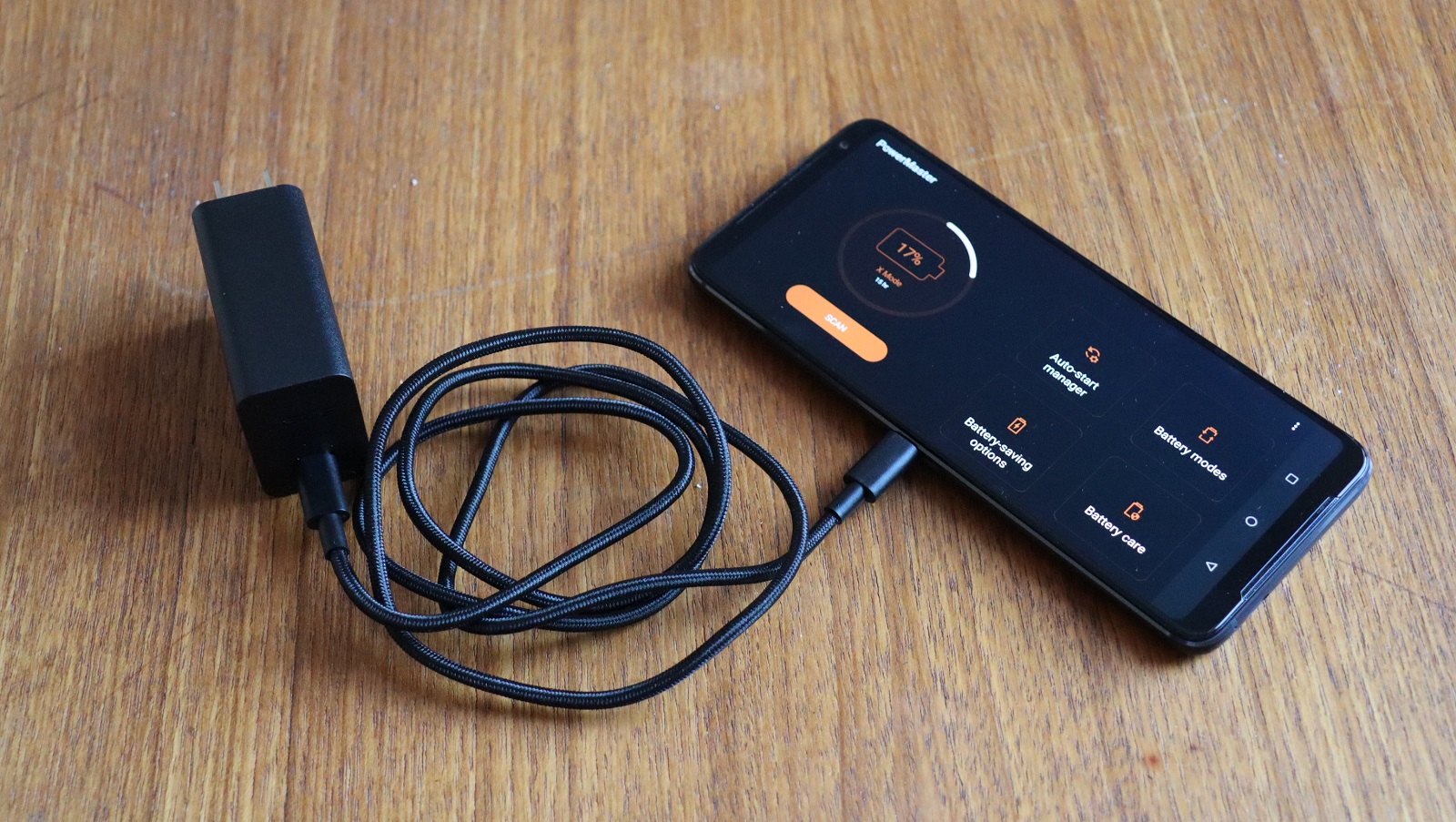
Battery
- 6,000mAh battery unchanged since ROG II, but still colossal
- 30W charger in box refills 50% capacity in an hour
- New 'slow charge' mode to maximize battery health longevity
The Asus ROG 3 has a 6,000mAh battery, which is the same size as the one in its predecessor. However, that capacity is still larger by far than that of the power packs in most other phones, including the Samsung Galaxy S20 Ultra’s 5,000mAh battery.
As such, it takes a while to recharge the phone completely, even using the 30W charger included in the box. For instance, it took us an hour to juice the phone from 9% to 68%, so don’t expect to get back to full capacity quickly – not that you should expect to do so with so much capacity to fill, but plan accordingly.
Thankfully, that side-mounted port makes it easy to recharge while playing games – and no, you won’t accidentally shove the lead into the wrong half of the wide slot, as only one section accepts USB-C.
Don’t get too excited, though: the ROG 3 doesn’t have wireless charging. Not only would this take up too much of the precious interior space needed for the large battery and components, it would have created extra heat that could have accelerated degrading of the battery, Asus claims.
The ROG 3 does have one interesting new battery feature: slow charging. Yes, you can deliberately drop the charging rate of the phone, and Asus claims this was actually a popular request from owners of prior ROG phones who didn’t want their batteries to decline as rapidly as they would if using fast charging (say, with the included 30W charger). You can also set a maximum level of charge – up to 70%, 80%, or 90% – which could similarly help to extend battery health.
Whether these are real enough issues to concern most users, Asus wouldn’t say, but they do provide the options for users who want them.
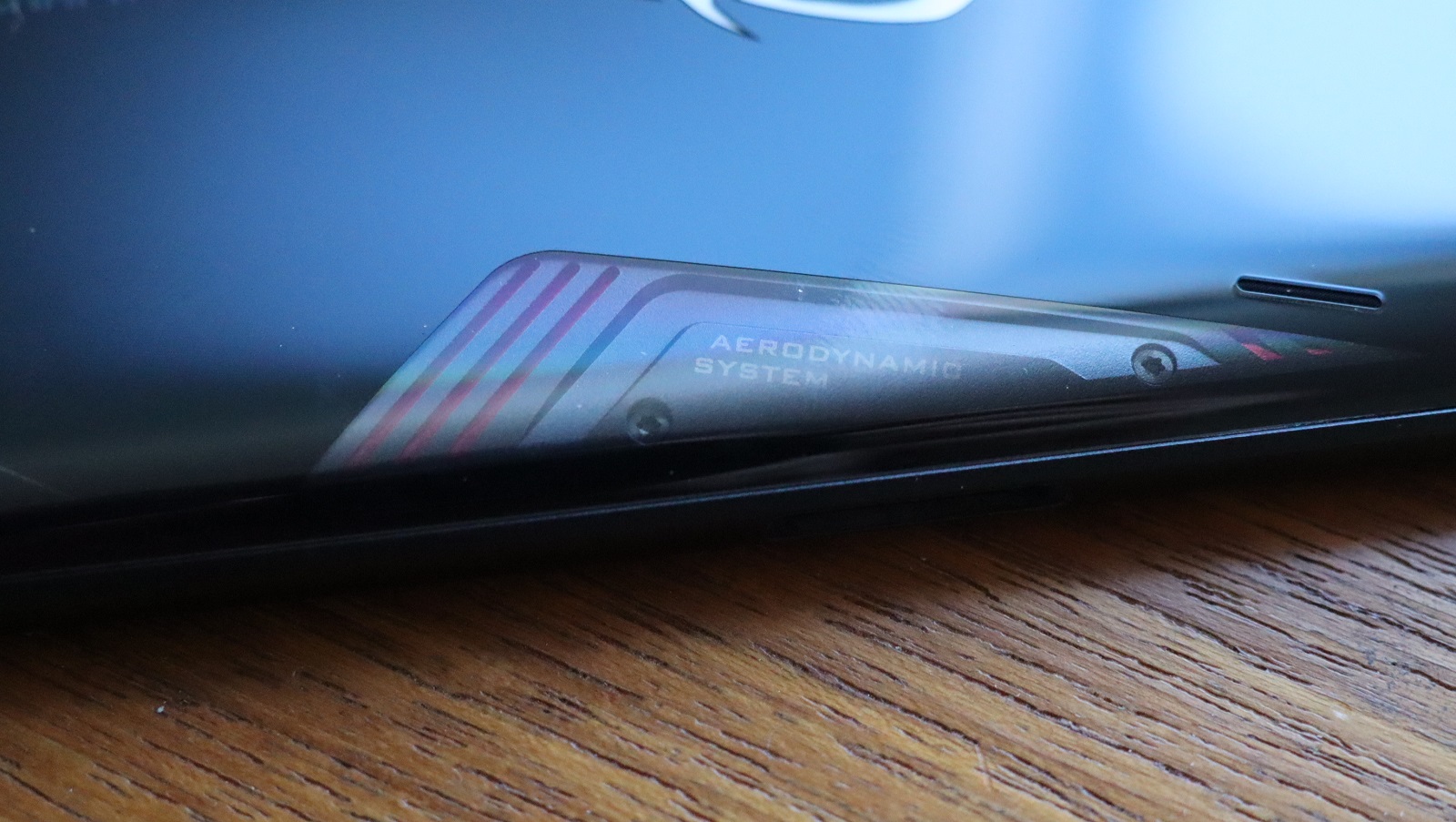
Buy it if…
You love mobile gaming
It's undeniable that the Asus ROG 3 is a powerful gaming phone, and potentially the best on the market. If you want a phone with plenty of ways to play and the tools to push performance, the ROG 3 is a no-brainer.
You want a huge battery
Even if you don't plan on gaming, the ROG 3 has one of the largest batteries of any phone out there. It will last you over a day, easy.
You want flagship perks but don’t care for photography
This may be a bit niche, but if you're fine with casual photography, the ROG 3 has plenty of features and perks that might entice consumers who want a device that's a powerhouse in all but cameras.
Don’t buy it if…
You need the best cameras
Conversely, consumers who want the sharpest photos may want to look at the Google Pixel 4 or iPhone 11, especially for night photography.
You want an affordable gaming handset
To be fair, we don't have the ROG 3's pricing details yet, but given the ROG II cost as much as most other flagships, we aren't expecting the new phone to be any cheaper. If you want affordable gaming, look elsewhere.
You want gaming features that are easy to use
The ROG 3's mobile gaming features are expansive compared to other phones, but they take some time to figure out – especially regarding which games are compatible with which perks, like AirTriggers.
First reviewed: July 2020
David is now a mobile reporter at Cnet. Formerly Mobile Editor, US for TechRadar, he covered phones, tablets, and wearables. He still thinks the iPhone 4 is the best-looking smartphone ever made. He's most interested in technology, gaming and culture – and where they overlap and change our lives. His current beat explores how our on-the-go existence is affected by new gadgets, carrier coverage expansions, and corporate strategy shifts.
